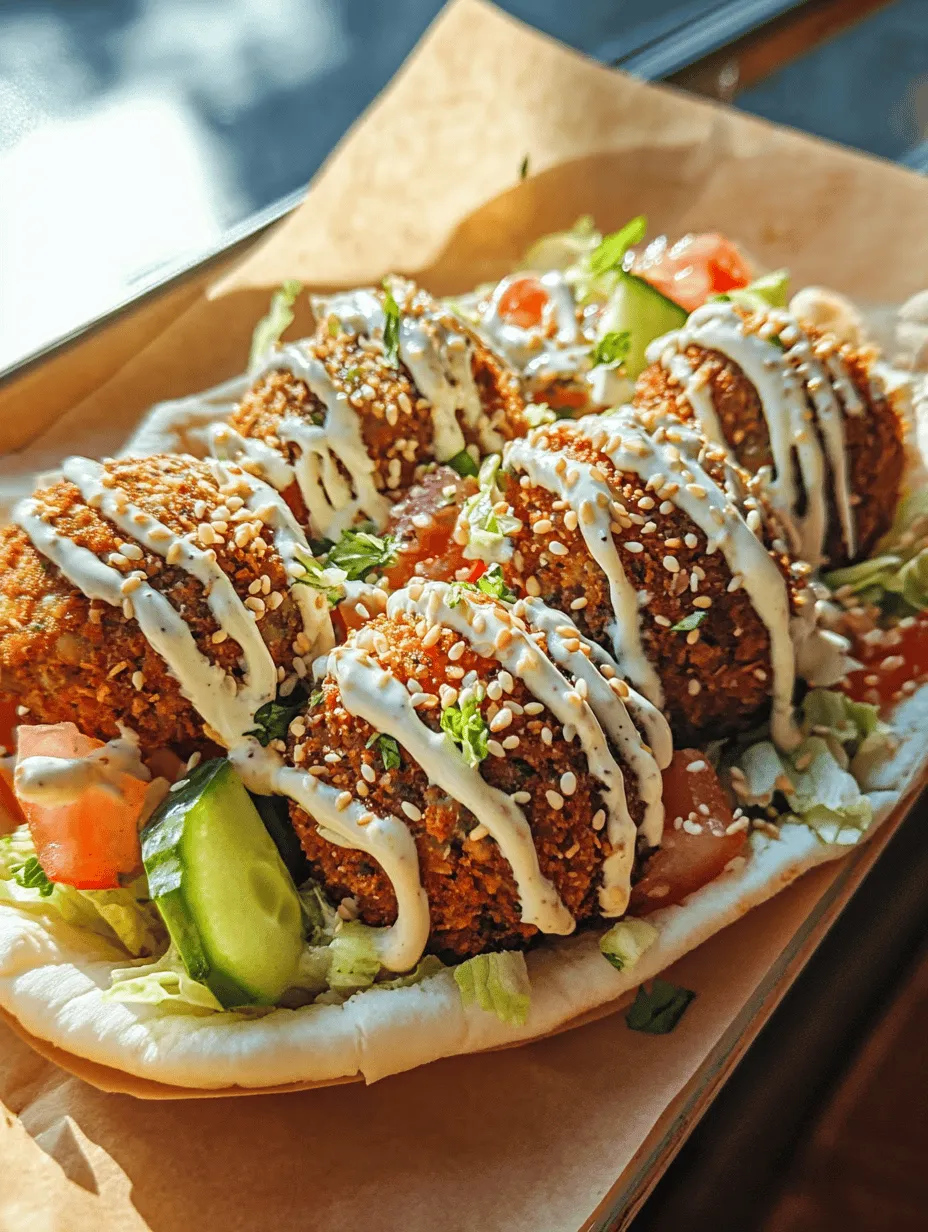Falafel, a beloved staple of Middle Eastern cuisine, is more than just a delicious street food; it’s a dish steeped in history and culture. In Egypt, falafel holds a special place, often served as a popular breakfast item or snack, enjoyed by locals and visitors alike. Made primarily from fava beans, this dish not only boasts a crunchy exterior and a moist, flavorful interior but also offers a wealth of health benefits. The combination of fresh herbs and aromatic spices truly elevates the humble falafel, making it a vibrant and satisfying option for any meal.
One of the most appealing aspects of crunchy Egyptian falafel is its delightful texture and flavor profile. The crispy crust yields to a tender, herb-infused center, delivering a burst of freshness with every bite. The use of fava beans provides a rich, earthy flavor while also packing the dish with protein, fiber, and essential nutrients. This recipe captures the essence of traditional Egyptian falafel, showcasing the importance of quality ingredients and authentic preparation techniques.
The History of Falafel
The origins of falafel trace back to Egypt, where it is believed to have been created by Copts, a Christian minority in the country, as a meat substitute during Lent. The original falafel was made from fava beans, which are locally abundant and rich in nutrients. Over the centuries, this simple dish evolved, spreading throughout the Middle East and adapting to various local tastes and ingredients.
As falafel traveled, it took on different forms. In places like Lebanon and Israel, chickpeas became the primary ingredient, resulting in a variation that has become widely popular today. Despite these adaptations, the essence of falafel remains the same: a deep-fried ball of seasoned legume mixture that is both filling and flavorful. Each region embraces its unique cultural influence, resulting in a diverse array of falafel recipes that reflect local culinary traditions.
In Egypt, falafel is not just a dish; it’s a part of the daily life and culture. It is often enjoyed in pita bread with fresh vegetables and tahini sauce or served on its own as a snack. The cultural significance of falafel in Egypt cannot be overstated, as it embodies the spirit of communal dining and hospitality that is central to Egyptian life.
Understanding the Ingredients
Creating the perfect crunchy Egyptian falafel starts with understanding the key ingredients that contribute to its distinct flavor and texture. The primary ingredient, fava beans, is not only a staple in Egyptian cuisine but also a nutritional powerhouse. They are rich in protein, fiber, and essential vitamins, making them a healthy choice for anyone looking to incorporate more plant-based foods into their diet.
Fava Beans vs. Split Peas
While split peas are sometimes used in falafel recipes, fava beans are the traditional choice for Egyptian falafel. Fava beans have a creamier texture and a slightly nutty flavor that enhances the overall taste of the falafel. They also have a lower glycemic index than split peas, making them a better option for those watching their blood sugar levels. Soaking the fava beans overnight is crucial, as it softens them and prepares them for blending into a smooth mixture.
Fresh Herbs: Parsley and Cilantro
A hallmark of Egyptian falafel is the generous use of fresh herbs, particularly parsley and cilantro. These herbs not only add brightness and color to the mixture but also contribute a fresh, aromatic quality that is essential to the dish. Parsley is known for its detoxifying properties and high vitamin content, while cilantro is celebrated for its anti-inflammatory benefits. Together, they create a flavor profile that is both refreshing and complex.
Spices that Enhance Flavor
To elevate the flavor of falafel, a blend of spices is used, including cumin, coriander, and cayenne pepper. Cumin adds a warm, earthy depth, while coriander offers a citrusy note that brightens the mixture. A dash of cayenne pepper provides a subtle heat that rounds out the flavors. These spices are not only integral to the taste of the falafel but also offer various health benefits, such as improved digestion and anti-inflammatory properties.
The Role of Tahini Sauce
No falafel dish is complete without a drizzle of tahini sauce. Made from ground sesame seeds, tahini is a creamy, nutty condiment that perfectly complements the crunchy falafel. In Egyptian cuisine, tahini is often used as a dip or sauce, enhancing the flavors of the dish while providing healthy fats and protein. Incorporating tahini into your falafel experience adds an extra layer of richness that is truly irresistible.
Preparing the Crunchy Egyptian Falafel
Now that we have an understanding of the ingredients and their significance, it’s time to dive into the preparation of crunchy Egyptian falafel. This step-by-step guide will walk you through the essential processes, ensuring that your falafel is both delicious and authentic.
Step 1: Soaking the Beans
Begin by soaking 1 cup of dried fava beans in plenty of water. It’s important to let them soak for at least 8 hours or overnight; this softens the beans and makes them easier to blend. Soaking also helps to reduce cooking time and enhances the texture of the falafel. If you’re using dried fava beans, avoid canned ones, as they will not yield the desired texture.
Step 2: Creating the Falafel Mixture
Once the fava beans are thoroughly soaked and drained, transfer them to a food processor. Add a handful of fresh parsley, cilantro, and a generous sprinkle of cumin and coriander. Pulse the mixture until it reaches a coarse consistency, ensuring that the beans are well blended but not pureed. The key is to achieve a texture that holds together but still has some bite.
Next, add minced garlic, a dash of cayenne for heat, and salt to taste. These ingredients will enhance the flavor and aroma of your falafel. Blend again until everything is evenly mixed, but avoid over-processing—you’re aiming for small bits rather than a smooth paste.
Step 3: Adjusting Consistency
At this stage, check the consistency of your falafel mixture. It should be moist enough to hold together when formed into balls but not too wet that it falls apart when frying. If it’s too dry, add a splash of water; if it’s too wet, you can incorporate a small amount of flour to bind it together. Remember, the right consistency is crucial for achieving that perfect crunch!
Step 4: Chilling the Mixture
Once your mixture is ready, place it in a bowl and cover it with plastic wrap. Let it chill in the refrigerator for at least 30 minutes. This step allows the flavors to meld and makes it easier to shape the falafel into balls or patties. Chilling also helps the falafel maintain its shape during the frying process.
Step 5: Shaping the Falafel
After chilling the mixture, it’s time to shape your falafel. Use your hands or a small ice cream scoop to form balls about the size of a golf ball. If you prefer, you can also shape them into patties for a different presentation. Ensure that each piece is compact and holds together well.
Step 6: Frying the Falafel
Heat vegetable oil in a deep frying pan or pot to a temperature of about 350°F (175°C). Carefully drop in the falafel balls, being mindful not to overcrowd the pan. Fry them in batches until they turn golden brown and crispy, typically taking about 4-5 minutes per batch. Use a slotted spoon to transfer the fried falafel to a plate lined with paper towels to drain any excess oil.
Final Thoughts
As you prepare to enjoy your crunchy Egyptian falafel, take a moment to appreciate the cultural significance of this dish and the care that goes into its preparation. With its crunchy exterior, flavorful herb-filled center, and the perfect accompaniment of tahini sauce, falafel is not just a meal; it’s a celebration of Egyptian culinary heritage. Whether enjoyed in a pita with fresh vegetables or on its own as a snack, falafel is a dish that brings people together, offering both nourishment and joy.

Benefits of Chilling the Mixture Before Frying
Chilling the falafel mixture is a crucial step that many home cooks often overlook. By allowing the mixture to rest in the refrigerator for a minimum of 30 minutes (and up to several hours), you enhance both the flavor and texture of your falafel. This resting period allows the ingredients to meld together, creating a more cohesive mixture that holds together better during frying.
How Chilling Enhances Flavor and Shaping
As the mixture chills, the flavors have a chance to deepen and develop. The herbs, spices, and legumes harmonize, resulting in a falafel that is rich in taste and aroma. Additionally, this cooling period firms up the mixture, making it easier to shape into balls or patties without crumbling. The chilled mixture will yield a denser, more structured falafel that can withstand the frying process, ensuring that each bite is perfectly crispy on the outside while remaining tender on the inside.
Frying Techniques for Perfect Falafel
Once your falafel mixture is chilled and ready to go, it’s time to dive into the frying process. Achieving the perfect falafel requires attention to detail, especially regarding the oil used, temperature control, and frying techniques.
Choosing the Right Oil for Frying
For frying falafel, the choice of oil plays a significant role in the final taste and texture. A neutral oil with a high smoke point, such as canola, vegetable, or peanut oil, is ideal for frying. These oils allow for a high frying temperature without imparting any strong flavors that could interfere with the taste of your falafel. Avoid using olive oil for frying as it has a lower smoke point and can lead to a bitter flavor when heated too high.
Temperature Control: Importance of Oil Temperature for Crispy Falafel
Maintaining the right oil temperature is vital to achieving crispy falafel. Ideally, the oil should be heated to 350°F (175°C) before adding the falafel balls. Use a thermometer to monitor the oil temperature; this will help ensure that your falafel cooks evenly and develops a golden-brown crust.
If the oil is too hot, the outside will brown too quickly while the inside remains raw. Conversely, if the oil is not hot enough, the falafel will absorb excess oil and become greasy rather than crispy. When you drop a falafel ball into the oil, it should sizzle immediately, indicating that the oil is at the right temperature.
Tips for Frying Without Overcrowding the Pan
To achieve perfectly fried falafel, it’s essential to avoid overcrowding the frying pan. Frying too many falafel at once can lower the oil temperature, leading to soggy results. Instead, work in batches, adding only a few falafel balls to the oil at a time. This allows each ball sufficient space to fry evenly, ensuring a crispy texture all around.
Identifying When Falafel is Perfectly Cooked: Golden Brown and Crispy
Perfectly cooked falafel will be golden brown and crispy on the outside while remaining soft and flavorful on the inside. Fry for about 3-4 minutes on each side, turning them gently to achieve an even color. Once they are done, use a slotted spoon to remove the falafel from the oil and place them on a plate lined with paper towels to absorb any excess oil. This ensures a delightful crunch with every bite.
Serving Suggestions for Egyptian Falafel
With your falafel perfectly fried, it’s time to think about how to serve these delicious treats. Traditional Egyptian falafel is often served in pita bread, accompanied by a variety of fresh vegetables and sauces.
Traditional Ways to Serve Falafel in Pita Bread
One of the classic ways to enjoy falafel is to stuff them into warm pita bread. Simply cut a pocket in the pita and fill it with a few falafel balls. The soft bread complements the crispy falafel, creating a delightful contrast in texture.
Ideas for Fresh Vegetable Toppings: Lettuce, Tomato, and Cucumber Combinations
Top your falafel-filled pita with a colorful array of fresh vegetables. Crisp lettuce, juicy tomatoes, and cooling cucumbers are traditional garnishes that brighten up your dish. You can also add slices of radish or shredded carrots for extra crunch and flavor. For an added zing, consider adding pickled onions or turnips, which are commonly found in Middle Eastern cuisine.
Discussion on the Use of Tahini Sauce and Its Flavors
No falafel is complete without a drizzle of tahini sauce. This rich, nutty sauce made from ground sesame seeds adds creaminess and depth to your falafel. To make tahini sauce, simply combine tahini, lemon juice, garlic, water, and a pinch of salt until smooth. Drizzle it over the assembled falafel for an authentic taste that beautifully complements the spices in the falafel.
Suggestions for Side Dishes: Pickled Vegetables and Hummus
For a complete meal, consider serving falafel with side dishes such as hummus and pickled vegetables. Hummus, made from blended chickpeas, tahini, lemon juice, and garlic, pairs beautifully with falafel. It adds a creamy texture and works as a dip or spread in your pita.
Pickled vegetables, such as turnips or cucumbers, provide a tangy contrast to the rich flavors of the falafel and hummus. These sides not only enhance the meal’s flavor profile but also contribute to the vibrant presentation.
Nutritional Benefits of Egyptian Falafel
Falafel is not just delicious; it’s also packed with nutrients, making it a smart choice for those seeking a healthy meal option.
Breakdown of Nutritional Content per Serving
Typically, a serving of falafel (about 3-4 balls) can provide significant amounts of protein and fiber. Made primarily from chickpeas or fava beans, falafel is a great source of plant-based protein, making it an excellent option for vegetarians and vegans. Additionally, falafel is rich in vitamins and minerals, including iron, magnesium, and folate, contributing to a well-rounded diet.
Discussion of Vegan and Vegetarian Diets and How Falafel Fits In
As the popularity of vegan and vegetarian diets continues to rise, falafel has earned its place as a staple food. It serves as a satisfying alternative to meat, offering similar protein benefits while being lower in saturated fats. Incorporating falafel into meals can help individuals meet their dietary needs without sacrificing flavor or satisfaction.
Health Benefits of Consuming Legumes and Fresh Vegetables
Falafel’s main ingredient, legumes, is known for its numerous health benefits. They are high in fiber, which aids in digestion and helps maintain a healthy weight. Furthermore, legumes are linked to reduced risks of chronic diseases, including heart disease and diabetes. When paired with fresh vegetables, falafel becomes a nutrient-dense meal that supports overall health and well-being.
Conclusion
Making homemade Egyptian falafel is a rewarding experience that brings joy not only to the cook but also to those who get to enjoy this delicious dish. The process of preparing and frying falafel offers a wonderful opportunity to explore the rich flavors of Egyptian cuisine, while also allowing for creativity in presentation and serving.
As you savor each crunchy bite, you’ll appreciate the versatility of falafel. Whether enjoyed in a pita sandwich, as part of a mezze platter, or as a standalone dish with sides like hummus and pickled vegetables, falafel is sure to please everyone at the table.
So, gather your ingredients, embrace the joy of cooking, and embark on a culinary adventure that celebrates the vibrant flavors of Egypt. With every batch of homemade falafel, you’ll find yourself not only sharing a meal but also sharing a piece of culture and tradition that has stood the test of time.



